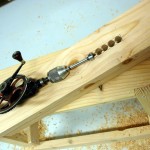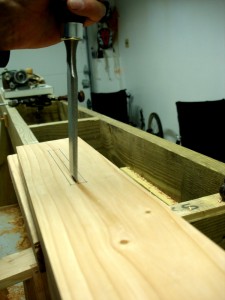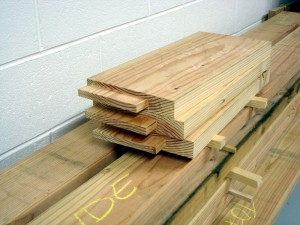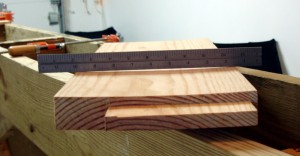The legs for the workbench are laminated from two pieces of 2 x 4. They are actually gotten out of rather nice 2 x 6s that aren’t nearly as gnarly and twisted as a typical 2 x 4.
After dimensioning the lumber and laminating the parts, it’s time to cut mortises. 
 The bottom rails are also 2 x 4 and fit in blind mortises in the thicker part of the legs. The way this is done in a powered workshop is with a drill press, using a fence to assure correct spacing of the mortise. As you can see, I’m using my made-in-1896 cordless drill and the chance of using an accurate fence is nil. Yeah, I toyed with making a block that could ride on the bit and act as a fence, but it didn’t seem stable enough. Instead, I incise the center line of the mortise with a chisel. Make that deep enough, and the center point of a forstner bit falls right in place. Nice! Now, there is one thing that a drill press can do that a hand drill cannot. With a drill press, the bit can be moved anywhere in the mortise to remove almost all the waste. Can’t be done by hand, so there’s a bit more chisel work to be done. Six legs, three rails, six blind mortises. These were my first mortise and tenon joints and I’m pleased with the results.
The bottom rails are also 2 x 4 and fit in blind mortises in the thicker part of the legs. The way this is done in a powered workshop is with a drill press, using a fence to assure correct spacing of the mortise. As you can see, I’m using my made-in-1896 cordless drill and the chance of using an accurate fence is nil. Yeah, I toyed with making a block that could ride on the bit and act as a fence, but it didn’t seem stable enough. Instead, I incise the center line of the mortise with a chisel. Make that deep enough, and the center point of a forstner bit falls right in place. Nice! Now, there is one thing that a drill press can do that a hand drill cannot. With a drill press, the bit can be moved anywhere in the mortise to remove almost all the waste. Can’t be done by hand, so there’s a bit more chisel work to be done. Six legs, three rails, six blind mortises. These were my first mortise and tenon joints and I’m pleased with the results.
Time to move to the upper rails. These guys are heftier, currently being 9 inches wide.  I got them out of a 2 x 10 that I know sat idle in an air conditioned Home Depot store for about three months. I had it in my shop about a week before I began working it. After dimensioning the wood, I rough cut it into the three pieces, noting that the newly cut ends felt about the same temperature as the outside edge of the wood. That’s a rough indication of relative dryness. (No, I’m not going to buy a $300 moisture meter.) I stickered the three pieces and let them sit for about a week while doing other things. When I came back to them, they were absolutely flat. So, I cut their tenons and set the pieces aside, still dead flat.
I got them out of a 2 x 10 that I know sat idle in an air conditioned Home Depot store for about three months. I had it in my shop about a week before I began working it. After dimensioning the wood, I rough cut it into the three pieces, noting that the newly cut ends felt about the same temperature as the outside edge of the wood. That’s a rough indication of relative dryness. (No, I’m not going to buy a $300 moisture meter.) I stickered the three pieces and let them sit for about a week while doing other things. When I came back to them, they were absolutely flat. So, I cut their tenons and set the pieces aside, still dead flat.
 A week later, I’m ready to cut mortises for these rails and I look over and see… Two of the three, all from the same board are now cupped. Yes, wood moves. Yet, I was a bit surprised to see these pieces change shape rather suddenly after being flat for a few weeks. It’s also interesting that the tenons aren’t cupped as much as the thicker part of the wood. No, I’m not going to flatten the pieces again. This is a workbench, not a grand piano, and those rails will do very well as they are. All of the important strength and bearing surfaces are unaffected by whether the piece is dead flat or cupped a bit.
A week later, I’m ready to cut mortises for these rails and I look over and see… Two of the three, all from the same board are now cupped. Yes, wood moves. Yet, I was a bit surprised to see these pieces change shape rather suddenly after being flat for a few weeks. It’s also interesting that the tenons aren’t cupped as much as the thicker part of the wood. No, I’m not going to flatten the pieces again. This is a workbench, not a grand piano, and those rails will do very well as they are. All of the important strength and bearing surfaces are unaffected by whether the piece is dead flat or cupped a bit.
Speaking of pianos, who needs a grand piano to play honky tonk music, except maybe Jerry Lee Lewis? His latest collection “Last Man Standing” is great music for drilling mortises.
Leave a Reply